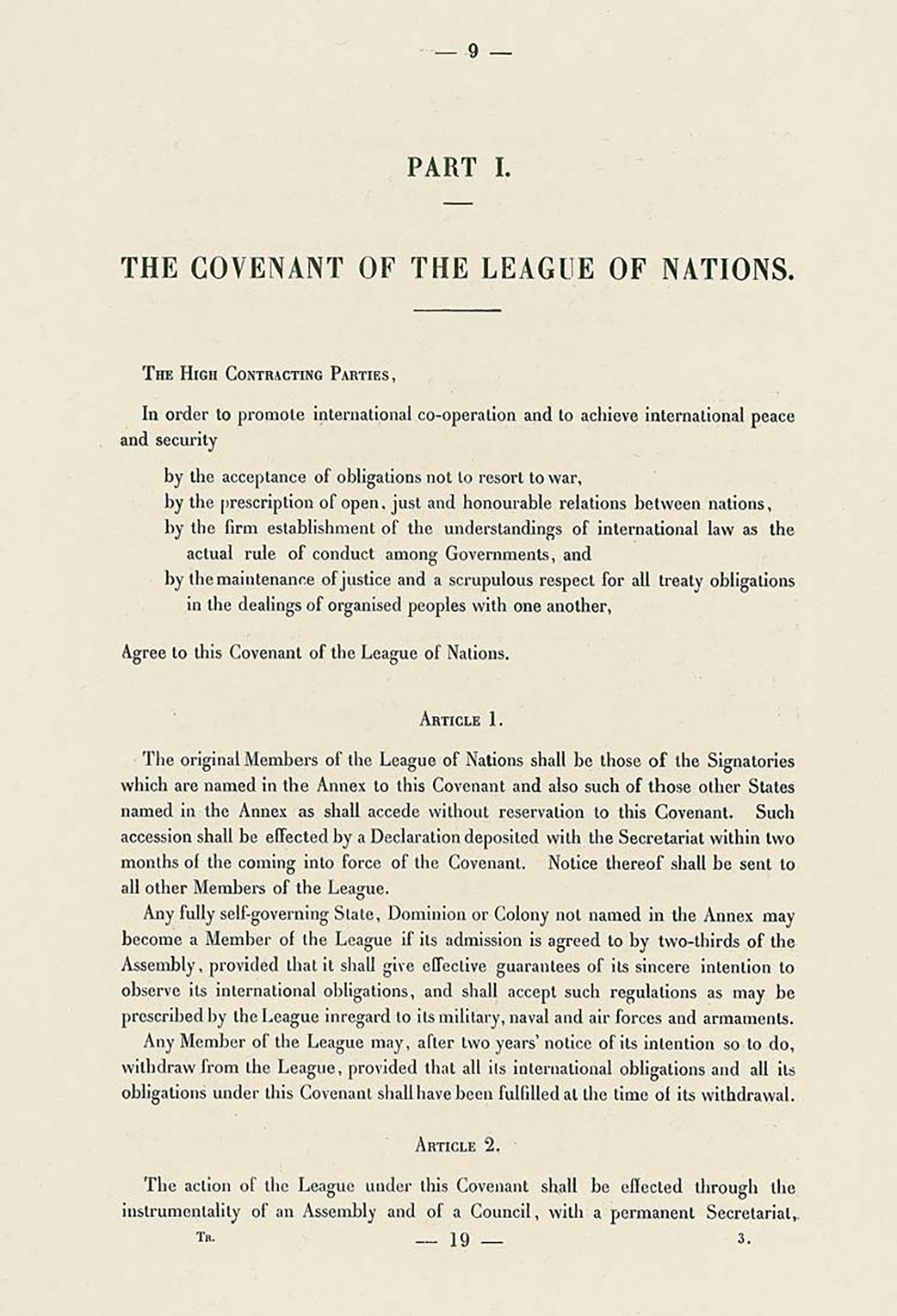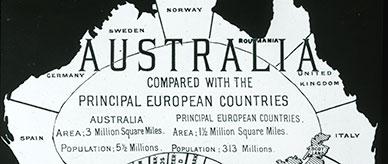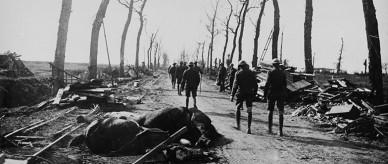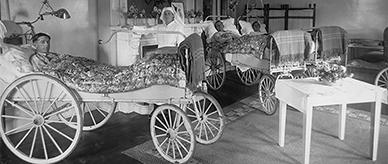


Transcript
-9-
[Heading:] PART I.
THE COVENANT OF THE LEAGUE OF NATIONS.
THE HIGH CONTRACTING PARTIES,
In order to promote international co-operation and to achieve international peace and security
by the acceptance of obligations not to resort to war,
by the prescription of open, just and honourable relations between nations,
by the firm establishment of the understandings of international law as the actual rule of conduct among Governments, and
by the maintenance of justice and a scrupulous respect for all treaty obligations in the dealings of organised peoples with one another,
Agree to this Covenant of the League of Nations.
[Subheading] ARTICLE 1.
The original Members of the League of Nations shall be those of the Signatories which are named in the Annex to this Covenant and also such of those other States named in the Annex as shall accede without reservation to this Covenant. Such accession shall be effected by a Declaration deposited with the Secretariat within two months of the coming into force of the Covenant. Notice thereof shall be sent to all other Members of the League.
Any fully self-governing State, Dominion or Colony not named in the Annex may become a Member of the League if its admission is agreed to by two-thirds of the Assembly, provided that it shall give effective guarantees of its sincere intention to observe its international obligations, and shall accept such regulations as may be prescribed by the League inregard [sic] to its military, naval and air forces and armaments.
Any Member of the League may, after two years’ notice of its intention so to do, withdraw from the League, provided that all its international obligations and all its obligations under this Covenant shall have been fulfilled at the time of its withdrawal.
[Subheading] ARTICLE 2
The action of the League under this Covenant shall be effected through the instrumentality of an Assembly and of a Council, with a permanent Secretariat,
[Footer:] TR. -19- 3.
About this record
This is the first page of the Covenant of the League of Nations, which is Part 1 of the Treaty of Versailles, the peace treaty to conclude World War I signed at Versailles, France on 28 June 1919 by the Allied nations and Germany. It begins with four guiding principles designed to promote international cooperation, peace and security and that underpin the articles of the Covenant. The document includes Article 1, which describes how a state can become a member of the League of Nations. It is taken from Australia's authenticated copy of the treaty.
Educational value
- The Covenant of the League of Nations bound members to uphold world peace and promote international cooperation. Members agreed not to resort to war but to settle disputes peacefully by referring them to the League's Council for arbitration or judicial settlement. They agreed to respect the territorial integrity and political independence of member states, and if necessary to take collective action, such as economic or military sanctions, to defend members from aggression.
- The League of Nations was the first international forum of governments set up to resolve international disputes and to promote international cooperation with the aim of maintaining world peace and security. The commitment made by League members to open discussion and resolution of disputes marked a radical departure from the diplomacy of the past, which had been largely conducted in secret, while the pledge to maintain a collective security was also new.
- The Covenant of the League of Nations, which set out the terms of peace after World War I, was the first international political treaty signed by Australia and the first in which it was directly involved in negotiations. Australia was among 32 signatories to the treaty and a founding member of the League of Nations. Australia’s involvement demonstrated that, while it was still a British dominion and at Versailles a member of the British delegation, it was emerging as an independent entity on the world stage.
- The League of Nations comprised: an Assembly made up of all member nations; the Council; the Secretariat based in Geneva, Switzerland, that carried out administration; and the Permanent Court of International Justice. The Council initially had four permanent members – Italy, Britain, France and Japan – with four member nations chosen by the Assembly on a rotating basis. Authorisation for any action required a unanimous vote by the Council and a majority vote in the Assembly.
- Countries could become members of the League of Nations by ratifying the Treaty of Versailles within two months of signing, and by doing so acceded to the Covenant. Despite president Woodrow Wilson's role as an architect of the League, an increasingly isolationist United States Congress failed to ratify the treaty, fearing it would cede the United States government's war powers to the League and could embroil the nation in future wars overseas.
- After the League of Nations was set up in 1920, nations were permitted to join if two-thirds of League members agreed. Germany, a signatory to the treaty, was excluded until 1926 when the League judged that its government had proven it could act responsibly, but it withdrew in 1933. At its largest the League had 58 members. However, having failed to prevent World War II, the League disbanded in 1946 and handed its mandate to the United Nations.
Acknowledgments
Learning resource text © Education Services Australia Limited and the National Archives of Australia 2010.
Related themes
Need help with your research?
Learn how to interpret primary sources, use our collection and more.



